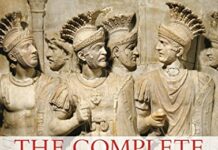
Ebook Info
- Published: 2014
- Number of pages: 94 pages
- Format: PDF
- File Size: 16.07 MB
- Authors: Adrian Goldsworthy
Description
Julius Caesar and Pompey the Great were two of the greatest generals Rome had ever produced. Together they had brought vast stretches of territory under Roman dominion. In 49 BC they turned against each other and plunged Rome into civil war. Legion was pitched against legion in a vicious battle for political domination of the vast Roman world. Based on original sources, Adrian Goldsworthy provides a gripping account of this desperate power struggle. The armies were evenly matched but in the end Caesar’s genius as a commander and his great good luck brought him victory in 45 BC.
User’s Reviews
Reviews from Amazon users which were colected at the time this book was published on the website:
⭐As I say in my Amazon’s AYA page I’m a history buff. Caesar is one of my favorite historical characters. I’ve read his “Commentaries” and “The Civil War”, Suetonius’ “The Twelve Caesars”, Plutarch’s “Lives” and a score of contemporary books about his life.After reading Kate Gilliver’s “Caesar’s Gallic Wars” in this same collection I went for this volume.I wasn’t disappointed. Osprey’s Essential History is a great resource for History “aficionados”, in a very compact book series with excellent presentation, first quality paper and nice reproductions gives the reader a succinct and complete view of the subject.This is a great resume of the Roman Civil War (49 – 44 BC). In only 96 pages (the customary format) Adrian Goldsworthy gives a complete, clear and accurate picture.Maps of all main battles are wonderful and detailed, helping to understand the positioning and evolution of the confronting forces.Mr. Goldsworthy starts with a synopsis of the events preceding the break out of the war, the different actors, the balance of power and the political situation of the last days of the Republic. Continue with a description of Roman’s Legion, composition, leadership style and combat doctrine. Next he focuses on the Civil War itself, starting with the Rubicon crossing till the final battle of Munda.Jumping from the general picture to the intimacies of “real people”, the author reconstruct the experiences of a Centurion, Cicero and Caesar himself; putting the reader in touch with “everyday” occurrences.Finally a short description of what happened after Caesar’s murder is given completing the picture of those turbulent days.As a bonus Mr. Goldsworthy provides thumbnail bios of main characters. This is a very helpful feature due to the repetitive use of patronymics done by Romans which tend to confuse sometimes the reader.This book may suites as an introduction for neophytes or as a graphic resume for students and researchers.Reviewed by Max Yofre.
⭐good book
⭐Adrian Goldsworthy, a leading classicist gives a good short introduction to the Roman Civil War of 49-44 BC. Admittedly all of the surviving sources are prejudiced against Pompey the Great and for Julius Caesar as Goldsworthy himself admits (for in the ancient the victors really did write the history), but still Goldsworthy’s attitude to Caesar borders on hero worship. It is not for nothing that the title is “Caesar’s Civil War” instead of the Roman Civil War or even “Pompey’s Civil War”. One supposes that this is the best monument to Caesar’s legendary charisma that some two thousand odd years after his assassination that men are still championing his cause. Truly Caesar has won the immortality that he sought some avidly during his life.If one can get the above caveat, this is a very good summary of the civil war and how it relates to the broader downfall of the Roman Republic. Goldsworthy offers a concise summary of the problems of the late Republic, above all the refusal of the Senate to recognize that Rome now had a full-time professional army instead of the old militia, and consequently its unwillingness to properly provide for veterans. At the same time, Italy was suffering from overpopulation, and there were far too many impoverished young men with nothing to lose seeking out a military career, this was an explosive mixture. Combined with the already highly competitive political structure in which scions of the patrician families fought fiercely with each other in order to score the greatest successes for Rome as a way of advancing their careers, and the increasing tendency of the Senate to let leading patricians equip, pay and led their own armies on behalf of Rome, the result was chaos. Essentially, anyone was rich and skilful to lead an army could and did muscle their way to the top. As Goldsworthy ably demonstrates, the rise of Julius Caesar cannot be understood unless one understands this background. There is no doubt that Caesar’s optimate opponents were right to see him in the elements of the adventurer and the populare demagogue, but if there had not been no mass of impoverished men with nothing to lose through fighting, Caesar would never had a following. At the same time, Goldsworthy does a fine job of explaining the tactics, equipment and organization of the legions.Admitting the biases of the sources, Goldsworthy is probably right that through Caesar expected and wanted a leading role in the Roman state, the main blame for the outbreak of the civil war must rested upon his optimate enemies in the Senate who were determined to freeze Caesar up of politics permanently. About the ambiguous actions of Pompey the Great, Goldsworthy is fair, suggesting that Pompey was uncertain if he wanted to be the optimate champion at first. Moreover, Goldsworthy makes a good case that Pompey was a great general past his prime, and the initiative with the younger and probably more talented Caesar.Goldsworthy presents a fine study of the Mediterranean war torn apart by civil war. There were good accounts of the leading battles fought against the length and breadth of the Mediterranean world in what is now modern Italy, France, Spain, Tunisia, Greece, Albania, Turkey and Egypt. Needless to say the leading highlight is the Battle of Pharsaulus, where Caesar met and destroyed the army of Pompey. Allowing for Goldsworthy’s evident admiration for Caesar, the way in which Caesar and his lieutenants won control of the entire Roman world in only five years does speak to a high quality of leadership. The accounts of the various battles are concise, well written and gives one a sense of the carnage and chaos of Roman warfare. No Hollywood heroics here, but rather grim, bloody struggles that makes one appreciate the devotion Caesar’s legions must had felt for him. Finally, Goldsworthy summarizes the contradictory evidence for what Caesar intended to do with his power once he had created his dictatorship for life. Most probably, Caesar didn’t have any well thought out plans. Indeed, Caesar had nothing, but the desire of having won supreme power of never giving it up. All said, a very good, readable introduction to one of the most important chapters in the fall of the Roman republic
⭐My first encounter, in Latin and fifty-some years ago, with Caesar’s three books and those of his continuators about the Roman civil war of 49-45 BC left me with the impression that they were a confusion of both personal and place names interspersed among unexplained accounts of marches and counter-marches. Untangling it all required no small amount of time with Cary’s “A History of Rome” and digging about in the Cambridge Ancient History. Goldsworthy, however, has assembled, organized, and made understandable an enormous amount of information needed to understand those four accounts, and has done so in less than 100 pages. His book begins with the stresses and strains on the Republic during its last century and ends with the appearance and nature of the Principate. In between, he outlines and summarizes the events and military campaigns of 49-45 BC into a coherent framework, which will enable his readers to read and understand the original texts (in Latin or translation!), and he even finds time to describe the soldiers of Rome and the most notable civilian, i.e., Marcus Cicero. So, if you want to understand the accounts of Caesar and his continuators, read this book first. For those who want more information, Goldsworthy provides a short bibliography of other ancient sources and modern scholarship. I offer a warning, however, to those who read the book, as I did, in Kindle format. In that format, the quality of some photographs is less than one might expect; captions are, in some cases, provided for omitted photographs; some captions have bled into the text; and maps and diagrams are usually to be found after the point where they’d prove most useful.
⭐A Good Book for non-academic readers who have an interest in Roman History but want it explained in everyday language.
⭐Brilliantly written, very detailed, and an incredibly fun read. This is why Adrian Goldsworthy is an amazing historian and author.
Keywords
Free Download Caesar’s Civil War: 49–44 BC (Guide to…) in PDF format
Caesar’s Civil War: 49–44 BC (Guide to…) PDF Free Download
Download Caesar’s Civil War: 49–44 BC (Guide to…) 2014 PDF Free
Caesar’s Civil War: 49–44 BC (Guide to…) 2014 PDF Free Download
Download Caesar’s Civil War: 49–44 BC (Guide to…) PDF
Free Download Ebook Caesar’s Civil War: 49–44 BC (Guide to…)

